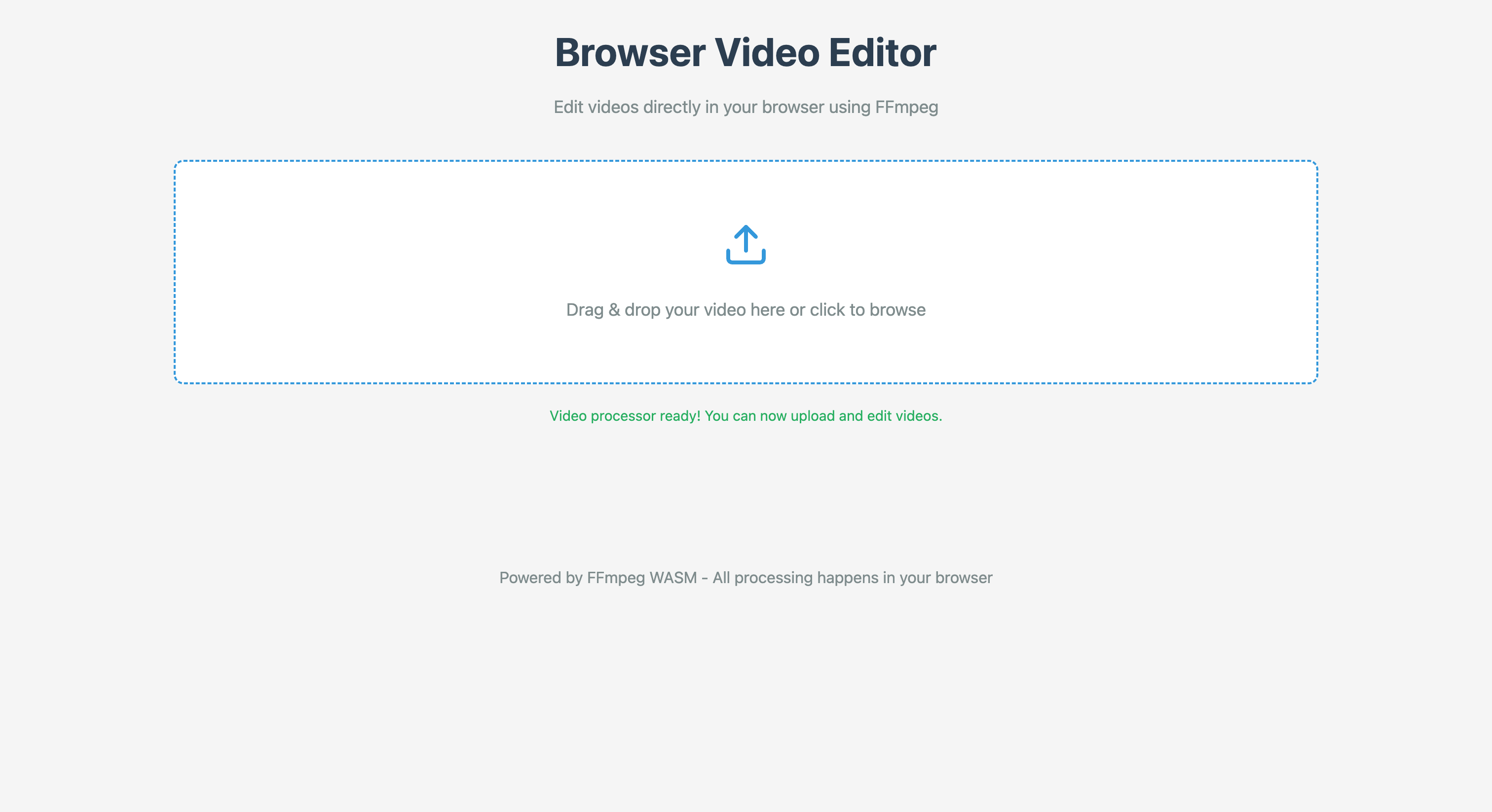I've always been fascinated by the idea of bringing powerful desktop applications to the web. That's why I decided to build a browser-based video editor using FFmpeg and WebAssembly. The result is Browser Video Editor, a tool that lets you edit videos entirely in your browser without uploading anything to a server.
 The Browser Video Editor interface with a simple drag-and-drop area for uploading videos
The Browser Video Editor interface with a simple drag-and-drop area for uploading videos
Why Build This?
We've all been there - you need to quickly trim a video, convert it to a different format, or extract audio, and you have to either:
- Download and install heavy desktop software
- Upload your video to an online service (privacy concerns!)
- Use command-line FFmpeg (not beginner-friendly)
I wanted to create something that combines the power of FFmpeg with the convenience of a web browser, all while keeping your videos private by processing everything locally.
The Technical Challenge
The biggest challenge was getting FFmpeg to run in the browser. FFmpeg is a powerful command-line tool written in C, and browsers can only run JavaScript. This is where WebAssembly (WASM) comes in - it allows us to compile C code to run in the browser at near-native speeds.
I used ffmpeg.wasm, which is a pure WebAssembly / JavaScript port of FFmpeg. This means:
- No server uploads needed - everything runs in your browser
- Your videos stay private
- No installation required
- Works on any modern browser
Key Features
The tool currently supports essential video editing operations:
Video Processing:
- Trim videos by specifying start and end times
- Convert between formats (MP4, WebM, AVI, MOV, and more)
- Compress videos by adjusting quality settings
- Extract frames as images
Audio Operations:
- Extract audio from videos
- Remove audio tracks
- Convert audio formats
Advanced Features:
- Adjust video resolution
- Change frame rates
- Apply video filters
- Merge multiple videos
The User Experience
I focused on making the interface as simple as possible:
- Drag and drop your video (or click to browse)
- Choose your editing operation
- Adjust settings if needed
- Click process and download the result
No accounts, no uploads, no waiting for server processing. Everything happens instantly in your browser.
Technical Implementation
Here's a simplified overview of how it works:
// Load FFmpeg WASM
const ffmpeg = createFFmpeg({ log: true });
await ffmpeg.load();
// Write input file to FFmpeg's virtual file system
ffmpeg.FS('writeFile', 'input.mp4', await fetchFile(videoFile));
// Run FFmpeg command
await ffmpeg.run('-i', 'input.mp4', '-t', '10', 'output.mp4');
// Read the output file
const data = ffmpeg.FS('readFile', 'output.mp4');
// Create download link
const url = URL.createObjectURL(new Blob([data.buffer]));The beauty of this approach is that FFmpeg's virtual file system runs entirely in the browser's memory. No data leaves your device.
Challenges and Solutions
Memory Management: Large video files can consume significant browser memory. I implemented:
- File size warnings
- Chunked processing for large files
- Automatic memory cleanup after processing
Performance: WebAssembly is fast, but not as fast as native FFmpeg. To improve UX:
- Added progress indicators
- Implemented web workers to prevent UI freezing
- Optimized FFmpeg commands for browser environment
Browser Compatibility: Different browsers have different WASM capabilities. The tool:
- Detects browser capabilities on load
- Falls back gracefully for unsupported features
- Shows clear error messages when needed
What's Next?
I'm excited about adding more features:
- Real-time video preview
- Batch processing multiple files
- More video filters and effects
- Simple video timeline editor
- Preset templates for common operations
Try It Yourself
The tool is completely free and open to use at ffmpeg.abhikhatri.com. Whether you need to quickly trim a video for social media, convert a file for compatibility, or extract audio from a presentation, it's all just a few clicks away.
Conclusion
Building this tool taught me a lot about WebAssembly, FFmpeg, and the current state of web technologies. It's amazing that we can now run complex video processing entirely in a browser. As browsers continue to evolve and WebAssembly becomes more powerful, I'm excited to see what other desktop-class applications we can bring to the web.
Give it a try and let me know what you think! Your feedback will help shape the future development of this tool.